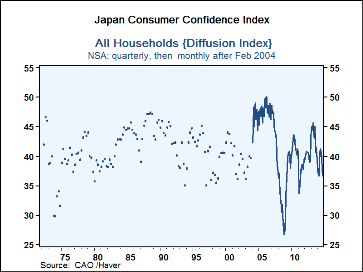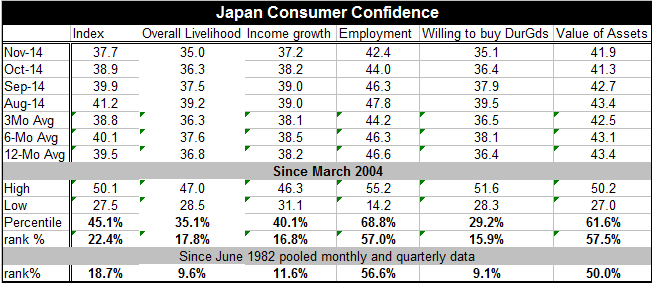 Global| Dec 10 2014
Global| Dec 10 2014Consumer Confidence in Japan Withers: What of the Future?
Summary
Japan's consumer confidence index in November fell to 37.7 from 38.9 in October. It was last weaker in April of this year. Japan's consumer confidence metric is a diffusion index. It was last above 50 (the expansion/contraction line [...]
 Japan's consumer confidence index in November fell to 37.7 from 38.9 in October. It was last weaker in April of this year. Japan's consumer confidence metric is a diffusion index. It was last above 50 (the expansion/contraction line of demarcation) in February of 2006. It has been over eight years since more households in this survey thought things were improving than thought things were deteriorating. That is a steep challenge to any attempt to brighten Japan's future by affecting expectations (as the BOJ is doing). Since March of 2004, when this report on Confidence began to be issued monthly instead of quarterly, the index has been lower than its current value only 18% of the time.
Japan's consumer confidence index in November fell to 37.7 from 38.9 in October. It was last weaker in April of this year. Japan's consumer confidence metric is a diffusion index. It was last above 50 (the expansion/contraction line of demarcation) in February of 2006. It has been over eight years since more households in this survey thought things were improving than thought things were deteriorating. That is a steep challenge to any attempt to brighten Japan's future by affecting expectations (as the BOJ is doing). Since March of 2004, when this report on Confidence began to be issued monthly instead of quarterly, the index has been lower than its current value only 18% of the time.
Japan has had debt problems lurking and threatening its success for well over twenty years. Japan's government has utilized supplemental budgets to try and boost or maintain government spending to keep growth aloft since at least the 1980s. But Japan is a country that has been victimized by its own success. Its determination to penetrate the US market with its exports and keep its position there led to an extraordinary appreciation of the yen. That in turn prompted a combination of responses ranging from outsourcing to increased capital intensity in manufacturing. Those responses for a while buffered Japan from the loss in competitiveness that stemmed from its overly strong exchange rate. But the yen's strength was ultimately Japan's undoing. For years Japan ran a persistent current account surplus and maintained surpluses even in the face of an overvalued yen because it was fearful of oil import costs and because it had a rapidly aging population leading it to have a high savings rate.
Still, Japan's method to keep growth rolling in a high savings economy was to rely on a build-up of government debt. Debt's ratio to GDP is now enormous and puts Japan in an awkward position internationally especially with an aging AND shrinking population. Japan does owe most of its debt to its own residents. Its recent nuclear calamity led to a nationwide nuclear shutdown that increased oil imports and thrust its current account into deficit for a time. Other than that episode Japan has been accumulating international and domestic assets.
The result of the higher yen was to help boost already high living costs in Japan; that in turn caused many of Japan's youth to decide to forego family formation as a way to deal with high living costs. Japan had pioneered the multigenerational mortgage to help people purchase houses what would have been unattainable with conventional mortgage metrics given skyrocketing housing prices.
Japan has "an ace in the hole", however. For years Japanese women have been essentially out of the work force or in it only tangentially. But Japanese women have begun to participate more in the job market. The BOJ is still full throttle with QE. These changes give Japan two new opportunities to get a leg up on growth.
Japan's consumption tax hikes seem to have punched the air out of the economy much more than had been expected. The blow was so great and its effect has been so lasting that the second round of tax hikes has been postponed. However, not all the news in Japan is negative; the yen has slipped but it does not help the economy as it once did because there has been so much outsourcing. The LEI for Japan in November is up for the third month in a row although its gains are slowing. Women are participating in the economy to a greater extent and the BOJ policy of QE is still in force.
Japan still has challenges ahead. One key might be for Japan's consumers to embrace a new way of life. It seems pretty clear that Japan will not in the future be the same as it was in the Post War period. The strong yen and excessive outsourcing to protect Japan's Kiritsu export markets has come at a heavy cost. But Japan is defiant about remaining a homogenous population; it will not solve the challenges of its shrinking population through immigration. That means Japan must find a new way to grow and a new way to prosper and to improve confidence.
Much of Japan's future revolves around its people's ability to navigate the economic maze that has become an ever changing challenge to prosperity. Japan seems to be trying to find a new way rather than just sticking to old practices that got it in trouble. That is the reason for hope. But hope has not yet become confidence.

Robert Brusca
AuthorMore in Author Profile »Robert A. Brusca is Chief Economist of Fact and Opinion Economics, a consulting firm he founded in Manhattan. He has been an economist on Wall Street for over 25 years. He has visited central banking and large institutional clients in over 30 countries in his career as an economist. Mr. Brusca was a Divisional Research Chief at the Federal Reserve Bank of NY (Chief of the International Financial markets Division), a Fed Watcher at Irving Trust and Chief Economist at Nikko Securities International. He is widely quoted and appears in various media. Mr. Brusca holds an MA and Ph.D. in economics from Michigan State University and a BA in Economics from the University of Michigan. His research pursues his strong interests in non aligned policy economics as well as international economics. FAO Economics’ research targets investors to assist them in making better investment decisions in stocks, bonds and in a variety of international assets. The company does not manage money and has no conflicts in giving economic advice.






